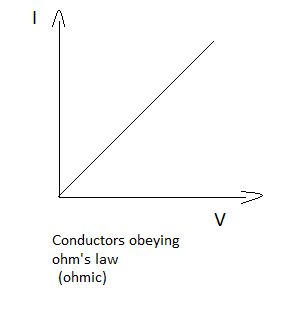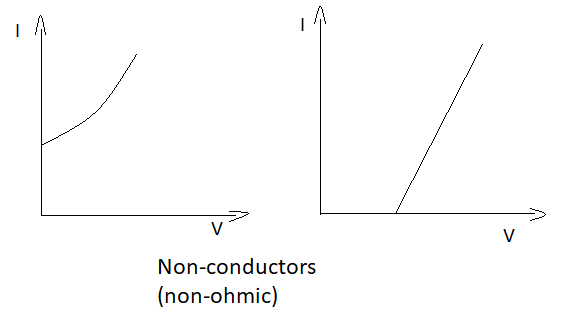Answer
393.3k+ views
Hint: Conductors that obey Ohm's Law are those which has a constant resistance when the current through them is increased or the voltage is varied across them. These conductors are known as ohmic conductors. If we plot a graph of the current vs. the voltage across these conductors, we will get a straight line.
Complete step-by-step solution:
The conductors which obey Ohm’s law are called Ohmic conductors. Ohm’s law states that temperature remaining constant current through the conductor is directly proportional to the voltage applied across the terminals of the conductor.
Below is the graphical representation with I-V curve of ohmic or non-ohmic or we can say conductors or non-conductors.


A transistor/diode is made up of semiconductors. All the semiconductor devices are non-ohmic because the current drawn by them is not proportional to the applied voltage. The voltage and current have a nonlinear relationship in the case of semiconductor devices. So, option (A and C) is wrong.
Liquid electrolytes are good conductors of electricity but they also have a non-linear relation between voltage and current just like semiconductors. So, option D is not correct.
Nichrome is an alloy of nickel and chromium (it sometimes also has iron). Nichrome has a constant resistance so it shows a linear relationship between voltage and current and thus is an ohmic conductor.
So, the correct answer is option B.
Note: Ohm’s law is one of the most fundamental laws of electricity and students often consider it to be universal. However, that is not the case, more conductors don’t obey Ohm’s law than there are that do. It’s always better to remember some examples of Ohmic and non-Ohmic conductors so that we can at least use the option elimination method to determine the answer.
Complete step-by-step solution:
The conductors which obey Ohm’s law are called Ohmic conductors. Ohm’s law states that temperature remaining constant current through the conductor is directly proportional to the voltage applied across the terminals of the conductor.
Below is the graphical representation with I-V curve of ohmic or non-ohmic or we can say conductors or non-conductors.


A transistor/diode is made up of semiconductors. All the semiconductor devices are non-ohmic because the current drawn by them is not proportional to the applied voltage. The voltage and current have a nonlinear relationship in the case of semiconductor devices. So, option (A and C) is wrong.
Liquid electrolytes are good conductors of electricity but they also have a non-linear relation between voltage and current just like semiconductors. So, option D is not correct.
Nichrome is an alloy of nickel and chromium (it sometimes also has iron). Nichrome has a constant resistance so it shows a linear relationship between voltage and current and thus is an ohmic conductor.
So, the correct answer is option B.
Note: Ohm’s law is one of the most fundamental laws of electricity and students often consider it to be universal. However, that is not the case, more conductors don’t obey Ohm’s law than there are that do. It’s always better to remember some examples of Ohmic and non-Ohmic conductors so that we can at least use the option elimination method to determine the answer.
Recently Updated Pages
What are the figures of speech in the poem Wind class 11 english CBSE

Write down 5 differences between Ntype and Ptype s class 11 physics CBSE

Two tankers contain 850 litres and 680 litres of petrol class 10 maths CBSE

What happens when eggshell is added to nitric acid class 12 chemistry CBSE

Why was Kamaraj called as Kingmaker class 10 social studies CBSE

What makes elections in India democratic class 11 social science CBSE

Trending doubts
Which are the Top 10 Largest Countries of the World?

Differentiate between orbit and orbital class 11 chemistry CBSE

Fill the blanks with the suitable prepositions 1 The class 9 english CBSE

What do you understand about stationary states class 11 chemistry CBSE

Difference between Prokaryotic cell and Eukaryotic class 11 biology CBSE

Differentiate between homogeneous and heterogeneous class 12 chemistry CBSE

Write the difference between order and molecularity class 11 maths CBSE

Common indicator organism of water pollution is A Escherichia class 12 biology CBSE

The Equation xxx + 2 is Satisfied when x is Equal to Class 10 Maths



